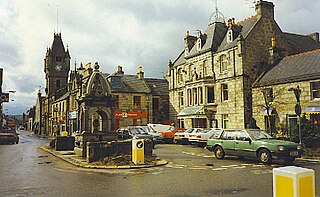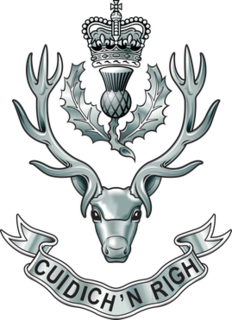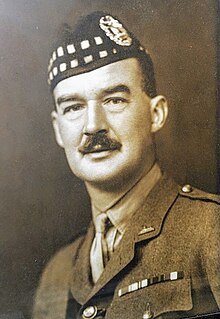
The Black Watch, 3rd Battalion, Royal Regiment of Scotland is an infantry battalion of the Royal Regiment of Scotland. The regiment was created as part of the Childers Reforms in 1881, when the 42nd Regiment of Foot was amalgamated with the 73rd (Perthshire) Regiment of Foot. It was known as The Black Watch from 1881 to 1931 and The Black Watch from 1931 to 2006. Part of the Scottish Division for administrative purposes from 1967, it was the senior Highland regiment. It has been part of the Scottish, Welsh and Irish Division for administrative purposes from 2017.

The 48th Highlanders of Canada is a Canadian Forces Primary Reserve infantry regiment based in Toronto, Ontario, parading out of Moss Park Armoury. The regiment is part of 4th Canadian Division's 32 Canadian Brigade Group.

Huntly is a town in Aberdeenshire, Scotland, formerly known as Milton of Strathbogie or simply Strathbogie. It had a population of 4,460 in 2004 and is the site of Huntly Castle. Its neighbouring settlements include Keith and Rothiemay. Both Huntly and the surrounding district of Gordon are named for a town and family that originated in the Border country.
The hackle is a clipped plume or short spray of coloured feathers that is attached to a military headdress, with different colours being associated with particular regiments.

The Royal Highland Fusiliers, 2nd Battalion, The Royal Regiment of Scotland is an infantry battalion of the Royal Regiment of Scotland.

The Highlanders, 4th Battalion, Royal Regiment of Scotland is an infantry battalion of the Royal Regiment of Scotland.

The Argyll and Sutherland Highlanders was a line infantry regiment of the British Army that existed from 1881 until amalgamation into the Royal Regiment of Scotland on 28 March 2006.

The Cape Town Highlanders is a reserve mechanised infantry regiment of the South African Army.

The Gordon Highlanders was a line infantry regiment of the British Army that existed for 113 years, from 1881 until 1994, when it was amalgamated with The Queen's Own Highlanders to form The Highlanders. Although the 'Gordon Highlanders' had existed as the 92nd Regiment of Foot since 1794, the actual 'Gordon Highlanders Regiment' was formed in 1881 by amalgamation of the 75th (Stirlingshire) Regiment of Foot and 92nd Regiment of Foot.

The Queen's Own Highlanders , officially abbreviated "QO HLDRS," was an infantry regiment of the British Army, part of the Scottish Division. It was in existence from 1961 to 1994.

The 51st Highland Volunteers is a battalion in the British Army's Army Reserve or reserve force in the Scottish Highlands, forming the 7th Battalion of the Royal Regiment of Scotland, also known as 7 SCOTS. It is one of two Reserve battalions in the Royal Regiment of Scotland, along with 52nd Lowland, a similar unit located in the Scottish Lowlands.

The Chief Langalibalele Rifles is a reserve infantry regiment of the South African Army.

The Royal Regiment of Scotland is the senior and only Scottish line infantry regiment of the British Army Infantry. It consists of three regular and two reserve battalions, plus an incremental company, each formerly an individual regiment. However, three regular battalions maintain their former regimental pipes and drums to carry on the traditions of their antecedent regiments.
Charles Davidson Dunbar, DCM was the first pipe major in Britain and the British Empire to be commissioned as a pipe officer. He emigrated from Scotland to Canada, where he came to be called "Canada's greatest military piper".

The city of Aberdeen in Scotland has amenities that cover a wide range of cultural activities, including a selection of museums and galleries. There are festivals and theatrical events throughout the year.
The 109th (Aberdeenshire) Regiment of Foot was an infantry regiment of the British Army from 1794 to 1795. Raised by Alexander Leith Hay for service in the French Revolutionary Wars the regiment was briefly deployed in Jersey before it was disbanded in England and its men sent to reinforce the 53rd (Shropshire) Regiment of Foot. The disbandment was controversial as Leith-Hay believed it contravened an assurance given to him in his original letter of service to raise the regiment.

The Regimental Pipes and Drums of The Calgary Highlanders is an authorized volunteer pipe band associated with The Calgary Highlanders of the Canadian Forces. For many years, the band was a bona fide, and separate, military unit unto itself, with a separate Unit Identification Code within the CF. Today, the band has been reduced to volunteer status but officially maintains an establishment of eight paid military musicians on its rolls. The band has had mixed success in competitions, but under the direction of Pipe Major Michael Giles had become successful in the Grade Three circuit in Alberta in the years leading up to the regimental centennial in 2010. The band published a recording to commemorate the 80th anniversary of the Regiment in 1990, titled Eighty Years of Glory and commemorated its centennial in 2010 by releasing a second CD entitled Onward.

The Guild Street drill hall is a former military installation in Aberdeen, Scotland.
Lt. Col. Frank Moffat (1894-1978) was a Scottish rugby union player. He became an international referee and the 66th President of the Scottish Rugby Union. He had a distinguished military career with the Gordon Highlanders in the First World War.

John Raymond Evelyn Stansfeld was a British army officer involved in the Relief of Ladysmith, the Battle of Spion Kop during the Boer War and the First Battle of Ypres. Stansfeld died at the Battle of Loos during World War I. He served with the Gordon Highlanders.

















